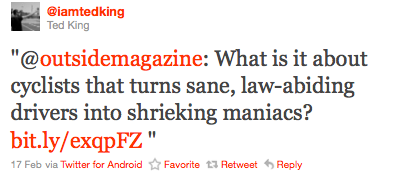Hi Everyone, I apologize for being AWOL in this here intertube, but the glorious life of graduate studentude has had me in the library studying things much less enjoyable than bicycles.
During a study break, I noticed on the Tweet-O-Sphere (why aren’t you following me, by the way?) that my good friend Ted King (he has no idea who I am) recommended an article from Outside Magazine promising to explain to me how “cyclists that can turn sane, law-abiding drivers into shrieking maniacs.”
Click here to go to the article (opens in a new window).
Given the current climate surrounding cyclists and people who hate cyclists (read: everyone else), I expected the usual drivel about how people get their non-lycra underclothing all twisted every time someone on a bike runs a red light or swerves in front of them to avoid a pothole. Remember, we as a group are UNPREDICTABLE AND LAWLESS!
So, I reluctantly clicked on the link, ready to have my self worth thrashed by some snide syndicated bike blogger who thinks they know everything about “bike culture.”
Much to my delight, this was instead an impressive summation of the bike vs. car culture war. I think you’ll enjoy reading the whole thing, but for those of you short of time or attention span, I provide the following highlights:
Of course, if calling cyclists “vulnerable” makes it seem like they’re never to blame, that’s not true, either. It’s not just those hipsters on fixies sealed off from the world by earbuds who give bikers an image problem. Plenty of well-meaning bike commuters aren’t aware of the laws, or fail to use bright flashing lights at night, or turn without giving hand signals. Statistically, some studies show cyclists running more red lights than drivers—for a number of complicated reasons, whether to conserve momentum, to get ahead of traffic and be more visible, or, more profoundly, perhaps because their out-group status leads them to act that way.
But the red lights may be a red herring. The way cyclists get hurt seems to have less to do with their own culpability and more to do with getting hit by cars—either from behind or when a car turns right, the way Simonetti was struck. Echoing research in the UK, a recent three-year study by Australia’s Monash University found that in 54 recorded crashes among a sampling of cyclists, drivers were at fault nearly nine out of ten times.
AND
In one study in which drivers were asked how they feel about cyclists, one of the recurring labels was “unpredictable.” When asked to elaborate, drivers often blamed the “attitudes and limited competence” of the cyclists themselves, rather than the “difficulty of the situations that cyclists are often forced to face on the road.” When asked to describe their own actions or those of other drivers, however, they blamed only the situation. Psychologists call this the “fundamental attribution error.”
AND (the most interesting part, for me)
In one sense, the so-called bikelash has little to do with transportation modes. In the late 1960s, a pair of British psychologists set out to understand the ways in which we humans tend to split ourselves into opposing factions. They divided a group of teenage schoolboys, who all knew each other, into two groups and asked them to perform a number of “trivial tasks.” The boys were then asked to give money to fellow subjects, who were anonymous save for their group affiliation. As it turned out, the schoolboys consistently gave more money to members of their own group, even though these groups had just formed and were essentially meaningless.
“The mere division into groups,” wrote the psychologists, Henri Tajfel and Michael Billig, of the University of Bristol, “might have been sufficient to have produced discriminatory behavior.” Though not exactly Lord of the Flies, the experiment was a demonstration of the power of what’s called “social categorization”—and the penalties inflicted on the “out-group.”


